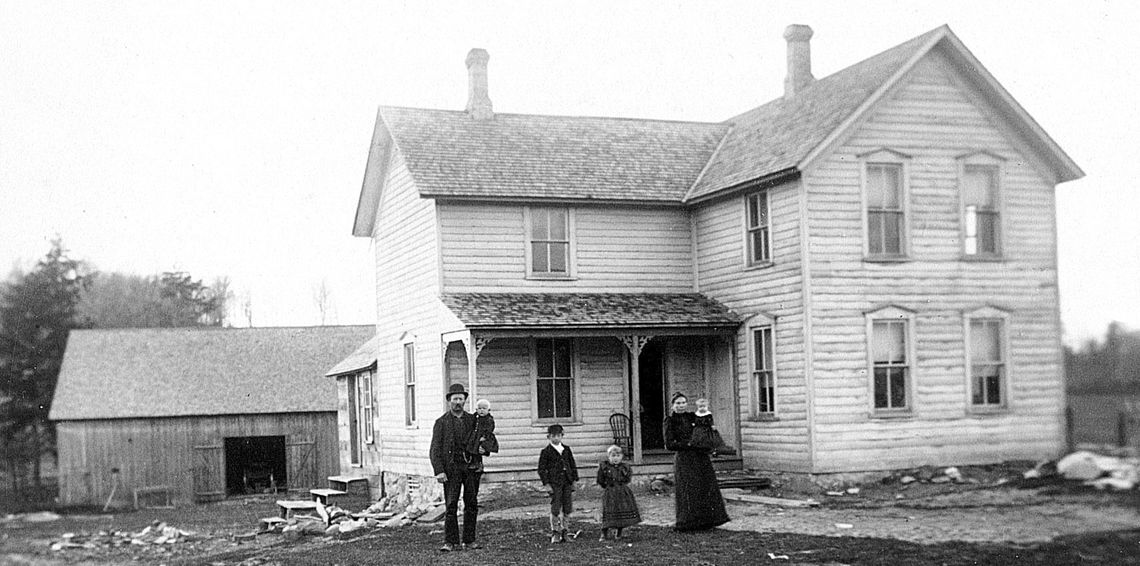This continues a series adapted from the book, “A Port Oneida Collection,” Volume 1 of the twopart set, “Oral History, Photographs, and Maps from the Sleeping Bear Region,” produced by Tom Van Zoeren in partnership with Preserve Historic Sleeping Bear. Here we have a look at the Richard & Katie Werner Farm, along M-22 just south of the bend by Thoreson Road.
As the children of Frederick and Margretha Werner (Ch. 6) came of age during the 1860’s 1890’s, most moved on to other areas. Several began farms across the county, in the Bingham area. The Werner Farm, meanwhile, became divided: daughter Margaret’s husband John Miller purchased the northern portion of the farm (where the buildings were), while son Dietrich (who went by “Richard”) bought 80 acres at the southern end for $400, and began the farm that now bears his name along M-22 just south of the bend by Thoreson Road.
Richard married an unwedded mother of two children, Catherina (Katie) Poertner. According to her great-grandson Gene Warner, Katie’s first child, August Warner, “was the product of an illicit affair,” presumably with a fisherman from North Manitou Island who was said to be “infamous for having affairs with girls on the mainland.” Four years later Ms. Poertner “had a second illegitimate child, my great-aunt Rachel (Warner). She eventually turned into a very attractive young woman, not looking much like her brother or mother, so might have been the product of a different affair.
“When I was a teenager, I asked my Grandma Rosie Warner about the difference in the names; part of the family being Warners and the other part Werners. Her story was that Grandpa August Warner had been a lumberjack, and his first paycheck had his name misspelled ‘Warner.’ In those days, she claimed, people never talked back to the boss, so he simply signed the checks ‘Warner’ and eventually the name stuck.”
Gene also told this alternate theory about the difference in names: “Years later, my Aunt Agnes Kelderhouse told me the story about the promiscuous young Kate Poertner having had the two illegitimate children, Grandpa Warner having been fathered by [a fisherman] from North Manitou . . . I vaguely remember someone telling that it was Richard’s mother [Margretha] who was adamant that Katie’s two ‘bastard’ children should not take on the Werner family name. At that point, the existing little boy and girl, probably around nine and five years old respectively, became August and Rachel Warner.” ~~~ Richard died at 39 after building a farm and adding two children to the family. The Grand Traverse Journal reported that he “met with a serious accident, having his leg broken below the knee. Everything was done for him that could be done, but to no avail.”
Katie, who inherited the farm, married Benjamin Holland, who took over and ran the farm for many years. Gene continues: “They were the great-grandparents I knew in the early 1940’s, Grandpa and Grandma Holland. ~~~ “Grandpa Holland was a pipe smoker, and always smelled like it. Otherwise he seemed far less scary than Grandma Holland. I was very young, and just remember their home place being a dark and ominous place occupied by a couple of uncomfortable old coots. I hated to go there, as opposed to visiting my other great grandparents, Henry and Maggie Haas on South Manitou, whose home was always bright and cheery.”
Neighbor Leonard Thoreson remembers Mr. Holland as a very particular man. “He would raise that cornfield, them rows were just as straight as could be. Very fussy. Very, very fussy with all his grain.”
To be continued








